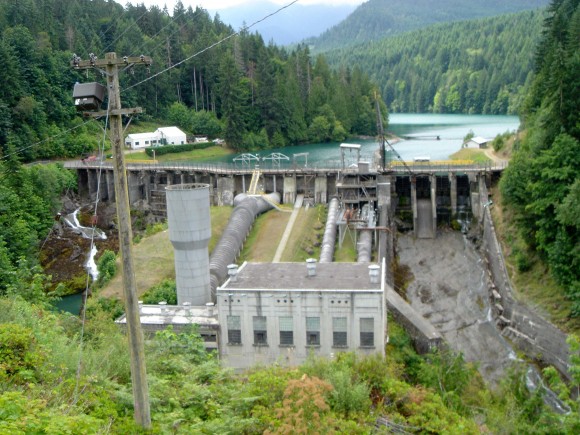
A New Trend in Dam Removal?
by: American Rivers: Amy Kober Posted on: September 08, 2011
By Amy Kober, Senior Communications Director for American Rivers.
Editor’s Note: This article by Amy Kober of American Rivers on the upcoming dam removals on the Elwha and White Salmon has been placed in our Fauna section, due to the positive impacts these dam removals will have on salmon and steelhead populations, among other fauna.
There has never been a more exciting time for river restoration in the Pacific Northwest. Preparations are underway to remove outdated dams to restore the health of the Elwha River in Olympic National Park, and the White Salmon River in the Columbia Gorge.
Demolition of the Elwha’s two dams will begin on September 17, 2011 and the White Salmon’s Condit Dam will come down starting in October 2011.
These back-to-back dam removals will provide for an unprecedented river renaissance in our region. The projects will be keystones in the efforts to restore Washington’s two main watersheds: Puget Sound and the Columbia River.
Tearing down the two dams on the Elwha will open up 70 miles of pristine habitat for salmon and steelhead. It will help restore an entire ecosystem, from the wild mountain peaks of Olympic National Park to the Strait of Juan de Fuca and Puget Sound. Biologists estimate that in about 30 years, 300,000 salmon and steelhead will return to the Elwha each year (compared to the current 3,000). The salmon will stitch back together the web of life, their nutrients supporting as many as 137 different species of animals, from mayflies to ravens to black bears to orca whales. The Lower Elwha Klallam Tribe will have the centerpiece of their culture and identity – the river and its salmon – renewed after a century of waiting.
The Elwha’s 210 foot tall Glines Canyon Dam will be the tallest dam ever removed in the world.
On the White Salmon, the removal of Condit Dam will have similar benefits – restoring access to habitat for salmon and steelhead and revitalizing the health of the river. Paddlers are excited to see what lies beneath Northwestern Lake, the reservoir behind the dam. The river’s upper reach is already a nationally-recognized whitewater boating destination. Ten outfitters run commercial trips on the river, and at least 25,000 boaters use the river each year.
Dams can provide valuable services like hydropower and water storage. Dams like those on the mainstem Columbia River play a central role in our region’s economy and will continue to do so. But there are some dams where the costs outweigh the benefits, and in these cases removal makes sense.
Dams harm river health in a number of ways, from blocking a river’s natural flow to preventing or impeding migrating fish like salmon from reaching spawning grounds. Dams can also impact water quality, pose public safety risks, and limit recreation opportunities.
Over the past decade, more and more communities and dam owners here in the Northwest and nationwide have embraced the removal of outdated dams as a tool to restore healthy rivers, clean water, fishing and recreation, and improve public safety.
Dam removal is often the cheapest way to deal with an old or unsafe dam. For example, analysis by PacifiCorp, the owner of Condit Dam, found that operating the aging dam under modern requirements just isn’t cost-effective. Dam owners like PacifiCorp should be applauded for making the responsible decision to remove an outdated dam – the best move for their ratepayers, and the environment.
Rivers are remarkably resilient. People are frequently amazed at how fast they come back to life. The dams on the Elwha and White Salmon will join a growing list of other dams removed across the Pacific Northwest. Marmot Dam on the Sandy River, just outside Portland, came down in 2007. Four dams were recently removed on southern Oregon’s Rogue River (three on the mainstem and one on Elk Creek, a tributary), which now flows freely for 157 miles from the Cascade foothills to the Pacific.
This fall, the state of Washington will celebrate its own river revival. The confluence of high-profile river restoration events, along with the fact that nationally we will soon reach a milestone of 1,000 dams removed, spurred us at American Rivers to dub 2011 The Year of the River.
It’s hard to know what will be louder, the roar of the rapids as the rivers come back to life, or the roar of the cheering crowds.
Amy Kober
American Rivers
Articles On Fauna
Fauna: Fauna
- Dec 4 Rapid Evolution and Adaptation to Climate Change: Salmon
- Sep 4 Orca Tribes of the Salish Sea and Beyond
- Jun 11 The Secret Life of Plastic
- Apr 29 The Tongass: The National Salmon Forest
- Jan 6 Oysters and Ocean Acidification
- Oct 6 Leave It to the Beaver!
- Sep 8 A New Trend in Dam Removal?
- Aug 31 There’s a New Bug in Town
- Jan 7 A History Lesson Concerning Fauna
- Oct 24 Salmon, Dams and the Snake River
- Oct 21 The Return of Washington’s Wolf Packs?
- Oct 21 A Fauna the WSDA isn’t Too Fond Of

